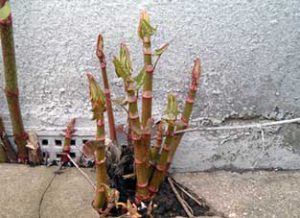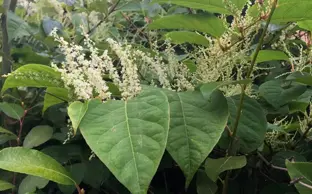How to Kill Japanese Knotweed
22-07-2016
Last updated 19-05-2023
How do I permanently get rid of Japanese knotweed?
There are two main methods of treating knotweed: the application of herbicides; and the digging up and disposal of its rhizome (root) system.
Herbicide treatment often leaves residual rhizomes in the ground that could regrow if they are disturbed, e.g. by construction or landscaping works. This means that herbicide treatment is often seen as a control measure, rather than effective eradication.
The only way to effectively eradicate knotweed as completely and as quickly as possible is to dig up the entire plant and appropriately dispose of it. Due to disposal costs for knotweed-contaminated material being very high, eradication by excavation can be much more expensive than control using herbicides.
What is the fastest way to get rid of Japanese knotweed?
The fastest and most effective way to get rid of knotweed is to dig it up and dispose of it (usually at an appropriately licenced landfill site).
As the rhizomes (roots) can spread very far and very deep into the ground, this can involve very large volumes of contaminated soil, even for a relatively small area of knotweed. Coupled with the high costs associated with knotweed disposal, the resulting fees for eradication by excavation can be very high.
What is the best chemical to kill Japanese knotweed?
Research has shown that currently, the most effective herbicide products to treat knotweed are those that contain glyphosate.
There have been other more effective chemicals available in the past, but legislation has stopped these from being legally used as they can persist in the ground for a long time after they are applied.
What kills Japanese knotweed naturally?
In its native range in Japan, knotweed can die back naturally from the impact of native insects that damage it, and from diseases and competing plants that limit its spread. It is also known to naturally die back in the centre of large stands, forming ‘rings’ of growth with dead centres. However, as there are no such controls on its growth in its introduced ranges in the UK and other countries, knotweed growth is not the same as in Japan and it does not naturally die.
These are the principal mechanisms that make knotweed particularly invasive where it has not evolved in balance with the ecosystems of the countries to which it has been introduced.
Can I burn Japanese knotweed?
Burning knotweed is often futile. It is only effective if it involves digging up the entire rhizome (root) system and completely burning all parts of the plant. The roots are often quite wet, so fuel will need to be added to the fire to allow it to burn. As knotweed grows on strongly alkaline volcanic soils in Japan, it has no problem growing through the ash of a fire built on top of it.
What spreads Japanese knotweed?
The main mechanism that causes knotweed to spread is the fragmenting of rhizomes into small pieces, which can happen when the ground within a few metres of the aboveground stems is disturbed.
If these fragments find their way into soils, wastes or building materials that are then moved to new locations, knotweed is likely to start growing there. As knotweed almost never grows from seed in the UK, this is generally considered to not be a mechanism of its spread.
Removing Japanese knotweed Yourself
Japanese knotweed is a common enough problem so why not try to kill it yourself?
Many people do, and some of them probably manage it with relative success. However, due to the complex legal issues surrounding knotweed and its impact on property, any DIY knotweed eradication effort will not protect you from the potentially costly legal consequences.
In fact, the whole reason there is a knotweed contractor’s trade body and detailed guidance for surveyors is due to banks and building societies needing knotweed risks to be managed professionally.
This is particularly important if you are looking to buy or sell a property affected by knotweed (which, incidentally, need not be on your land – growth on a neighbouring property could affect you too (read this blog post about buying knotweed-affected property).
Nevertheless, if such risks are not a concern, then there are a number of things you can do to kill knotweed, or at least significantly reduce its spread, yourself.
Herbicide Treatment
There is a wide range of herbicide products available to the general public from your local garden centre. The important thing is to make sure that the product you use is still in date and that you carefully follow the instructions on the label.
Some products will go out of date and their active ingredients may be withdrawn from approved use, so it is probably safest to go out and buy a product specifically for the intended purpose. To that end, most products will provide a list of plants that they are intended to treat, so make sure that Japanese knotweed is listed on the label.
The products available to professionals, who have to pass a series of exams in order to apply them, are much stronger than those available to the general public. You can therefore expect your own DIY treatment to take several years longer than the results obtained from a professional.
Digging it Up
The generation of rhizome fragments from excavating soil close to, and often several metres away from, knotweed plants and their potential spreading in the spoil arisings is the main mechanism of dispersal that has led to the proliferation of knotweed across the UK, Europe and North America.
Therefore, extra special care needs to be taken in any situation where there is a risk of disturbing and fragmenting knotweed rhizomes. Due to the ‘iceberg’ nature of the extensive and wide-spreading rhizome system, it’s very easy to do this without realising.
If you do, you risk breaking the law or opening yourself to litigation by spreading knotweed propagules.
If you are happy with the risks, digging up the rhizome system is the most immediate way to kill Japanese knotweed. However, dealing with the fragments can be more problematic.
Ideally they should be removed from site and disposed of at a licenced waste facility. A skip hire company can usually handle this, but expect costs to be several thousands of pounds per load. Special care still needs to be taken in handling the waste to ensure that rhizome fragments are not spread.
There are a range of other Japanese knotweed removal options following excavation that professionals utilise, such as burial and screening, but it’s not recommended that these are attempted as DIY projects.
Professional help
We realise that it is tempting to deal with Japanese knotweed infestations yourself – it is only a plant after all. However, the potential risks of prosecution, diminution in value of property and litigation make it much less attractive an option. If you are in any doubt, the peace of mind gained from using a professional with established qualifications cannot be over emphasised.
Phlorum was a founding member of the trade body that was established in consultation with the Council of Mortgage Lenders and the Building Societies Association to deal with property risks caused by Japanese knotweed. We were also part of the working group that produced the RICS guidance on knotweed surveys.
We offer a full range of specialist Japanese knotweed solutions, from surveys, consultancy, legal advice, including expert witness services and ‘boots-on-the-ground’ site works. If you have a knotweed issue that you’d like to discuss, please contact us.
We also have a FREE knotweed identification service where you can send us photographs of your suspected plants for a quick consultation. If you suspect you have knotweed, make sure you take a look at our guide to plants that look like Japanese knotweed.
We are here to help but we will respect your decision however you want to deal with your Japanese knotweed problem.




